-
main-collection-product-grid

Swiss Chard Seeds - Rainbow Mix
A very ornamental variety with orange, yellow, pink, white, and red stalksSwiss Chard Seeds - Rainbow Mix
A very ornamental variety with orange, yellow, pink, white, and red stalksRegular price As Low As $4.99Regular priceUnit price per -
main-collection-product-grid

Swiss Chard Seeds - Ruby Red
Nutritious green leaves decorated with scarlet veinsSwiss Chard Seeds - Ruby Red
Nutritious green leaves decorated with scarlet veinsRegular price As Low As $4.99Regular priceUnit price per -
main-collection-product-grid

Swiss Chard Seeds (Organic) - Ruby Red
Nutritious, delicious and attractiveSwiss Chard Seeds (Organic) - Ruby Red
Nutritious, delicious and attractiveRegular price As Low As $6.99Regular priceUnit price per -
main-collection-product-grid

Swiss Chard Seeds - Perpetual Spinach
Eat raw in salad or cooked like spinachSwiss Chard Seeds - Perpetual Spinach
Eat raw in salad or cooked like spinachRegular price As Low As $4.99Regular priceUnit price per -
main-collection-product-grid

Swiss Chard Seeds - Fordhook Giant
Resilient enough to grow in any climateSwiss Chard Seeds - Fordhook Giant
Resilient enough to grow in any climateRegular price As Low As $4.99Regular priceUnit price per -
main-collection-product-grid

Swiss Chard Seeds - Large White Rib
Thick, yet tender deep green leavesSwiss Chard Seeds - Large White Rib
Thick, yet tender deep green leavesRegular price As Low As $4.99Regular priceUnit price per -
main-collection-product-grid

Swiss Chard Seeds - Lucullus
Packed with Vitamins A and CSwiss Chard Seeds - Lucullus
Packed with Vitamins A and CRegular price As Low As $4.99Regular priceUnit price per
Growing heirloom swiss chard in your garden
- 7 swiss chard varieties
- Drought tolerant
- A cool-season heirloom vegetable
- Very similar to spinach and great as microgreens
Grow the best heirloom Swiss Chard in your Garden
Heirloom Swiss chard isn't actually native to Switzerland, but to the Mediterranean. Chard is a close relative of beets and spinach, and you can tell because it has the vibrant colors of beets but the sweet flavor of spinach. Swiss chard, on the other hand, is more heat and drought resistant than its cousins, allowing you to consume fresh chard throughout the warmest months of the year, when your spinach is likely to bolt.
How to plant your own Swiss Chard Vegetables
Heirloom Swiss chard may withstand light frosts and should be planted directly two to three weeks before the last spring frost. Chard seeds may be sown indoors four to six weeks before the last heavy frost to give your plants a head start on the season. Plant Swiss chard 40 days before the first fall frost for an October crop. Young chard leaves are tasty and may be plucked when they reach four inches in height. Baby chard has a milder flavor than older chard, and the tender leaves are ideal for salads. At roughly eight inches, mature chard leaves are ready to pick. Heirloom Swiss chard is a simple-to-grow crop that grows well in a variety of soil conditions.
Cooking with Heirloom Swiss Chard
Swiss chard might taste bitter in hot, dry conditions, but there are a few culinary approaches to hide the flavor. Simple and inexpensive strategies to improve the earthy flavor of this superfood include blanching or braising, pickling, and cooking with oil, salt, and acid. Separate the greens for wraps and sandwiches, then eat the heirloom Swiss chard midribs like celery. For a delightful, healthy tonic, sauté the entire leaf in oil or cut it up into a stew.
Do you know someone who has diabetes? Swiss chard is abundant in nutrients that help control blood sugar and protect your heart by decreasing cholesterol and blood pressure. Antioxidants in Swiss chard help to prevent cancer-causing free radicals. So put apples out of your mind. Now, a chard leaf a day keeps the doctor away.
Heirloom Swiss Chard for Microgreens
Microgreens are becoming popular as a fun and easy way to consume more veggies, and Swiss chard is a favorite for growing excellent seedlings. Fill a seed tray with dirt and multi-sow a pinch of Swiss chard seeds in each cell to grow heirloom Swiss chard as a microgreen. Water until the seedlings are two inches tall or have their first set of real leaves, whichever comes first. Cut portions of seedlings at the base with a pair of scissors. Enjoy these microgreens within a few days after picking, and plan weekly succession plantings to ensure a steady supply.
Whether you are already a fan of Eden Brothers' heirloom Swiss chard seeds or you’ve yet to try it, this is the season to grow this beautiful superfood in your garden!
For more information about planting, growing, and harvesting heirloom Swiss chard seeds, see the Swiss Chard Seeds Planting Guide.






